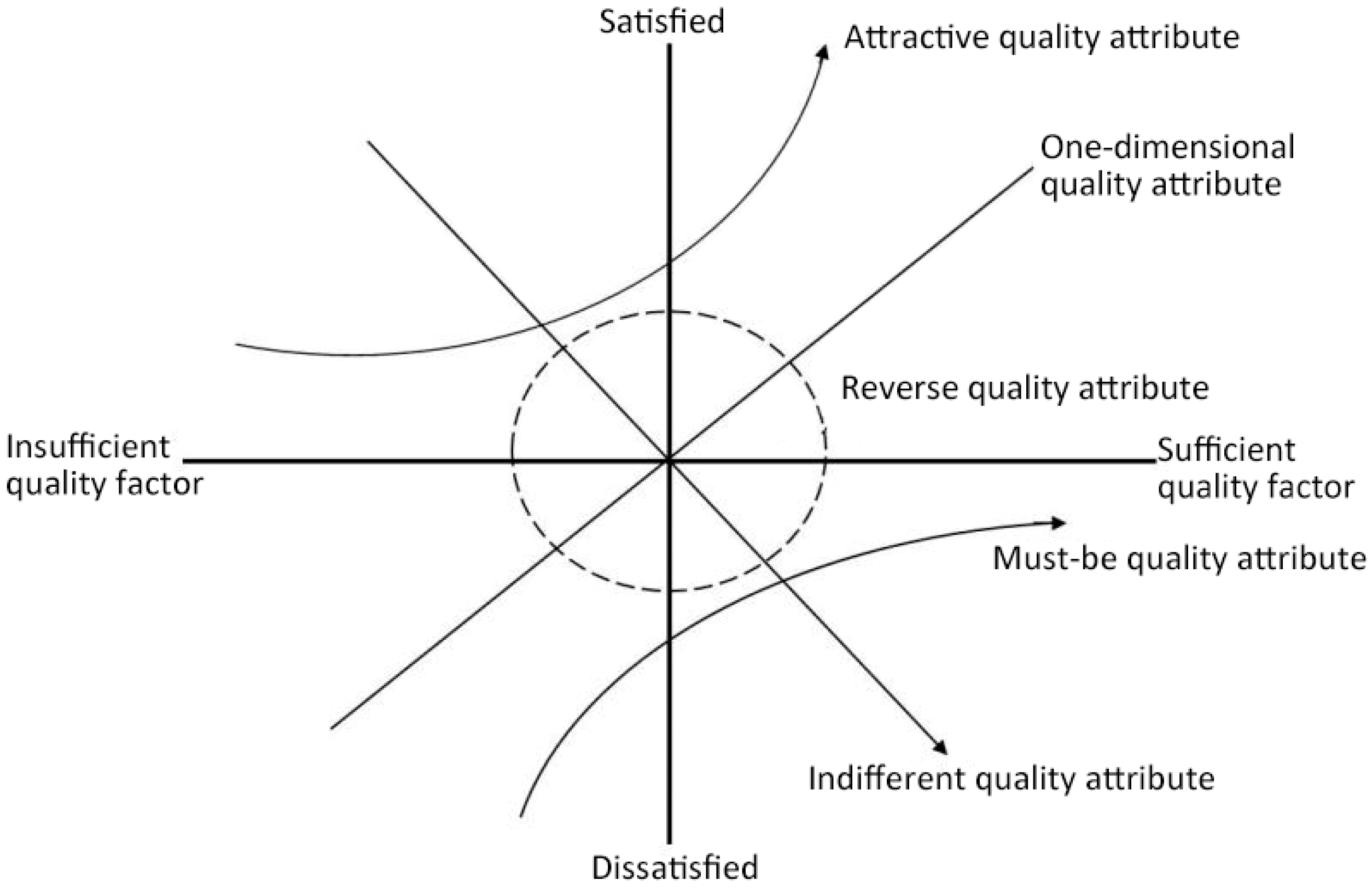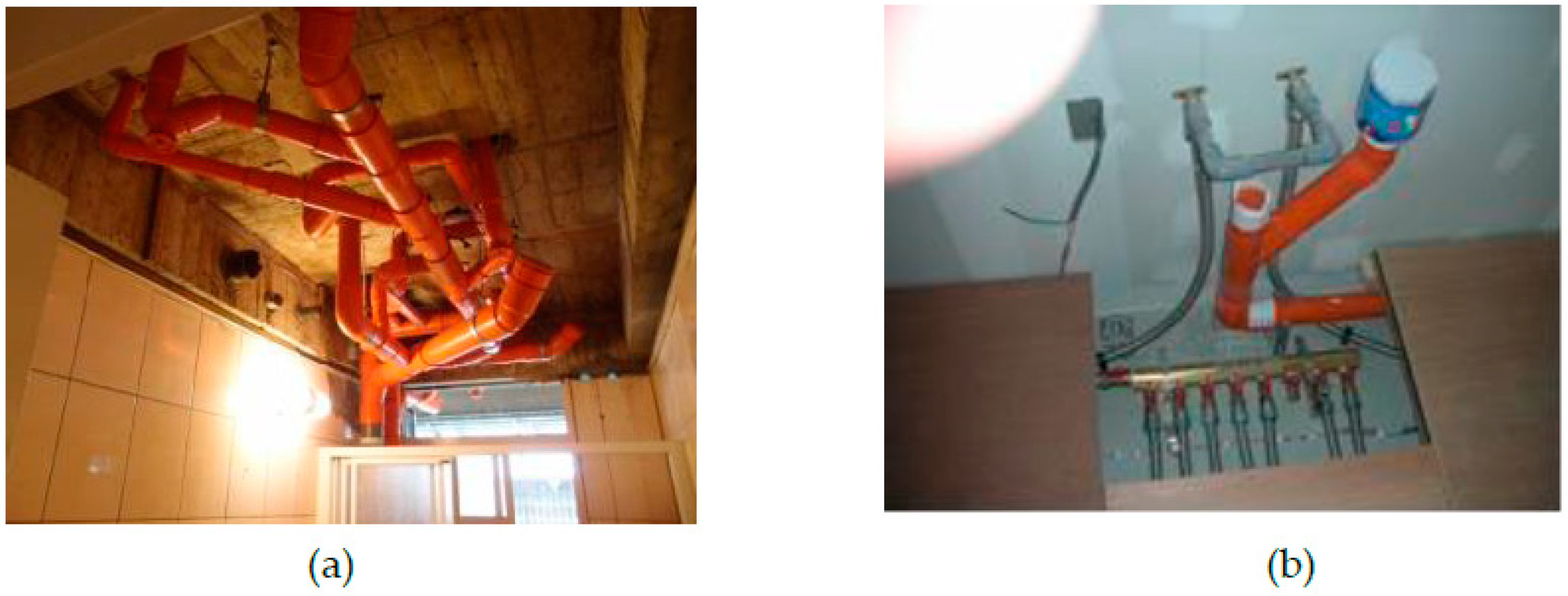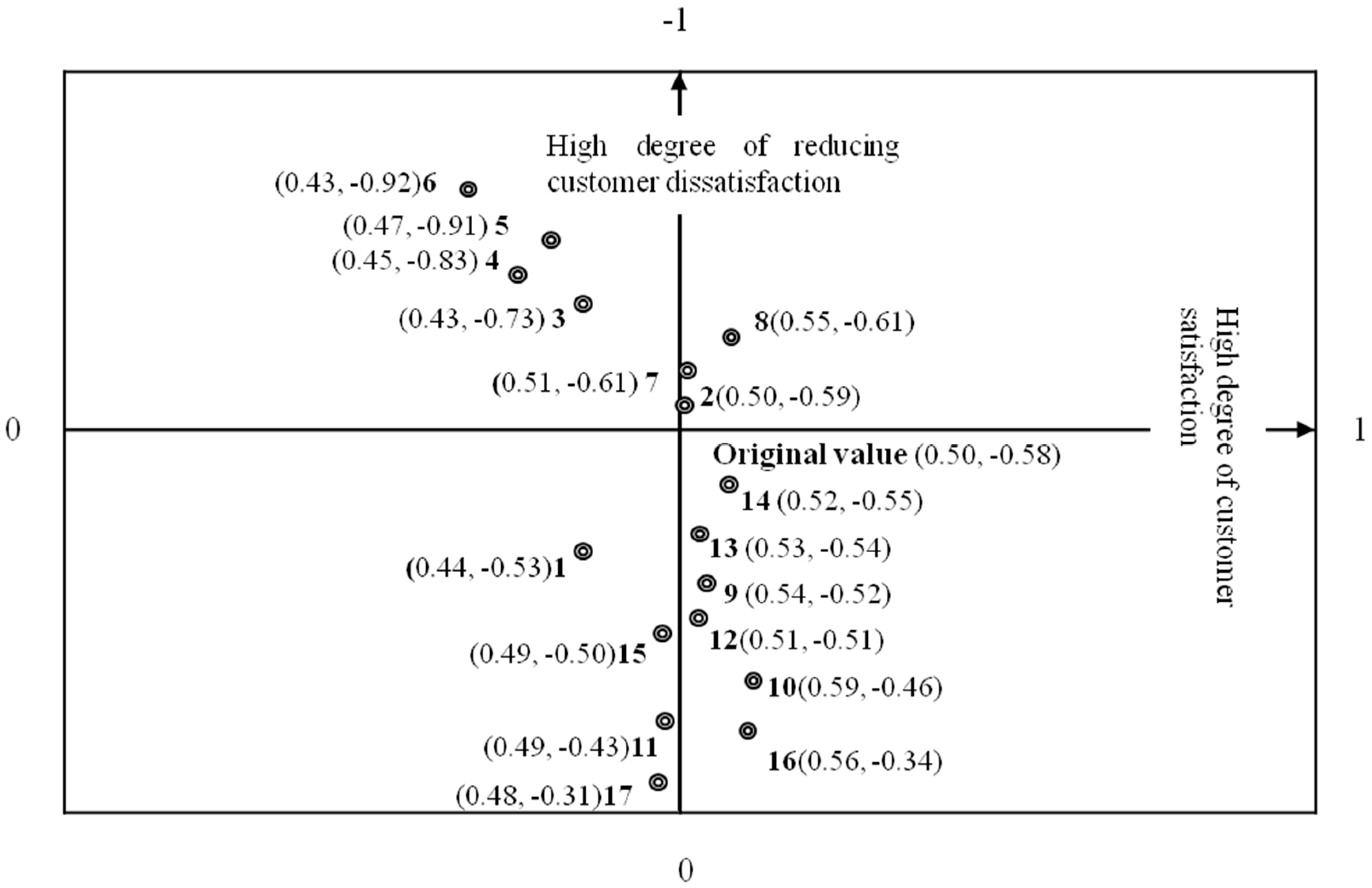Applying Kano Two-Dimensional Quality Model to Build the Performance Evaluation Indicators of Long-Life High-Quality Condominiums
Abstract
1. Introduction
2. Literature Review
2.1. Sustainable Development and Maslow’s Hierarchy of Needs Theory
2.2. Open Building Theory
2.3. Evaluation Categories for Activation and Reutilization of Buildings
3. Comparative Analysis of Housing Performance Evaluation Indicators
4. Research Method
4.1. Kano Two-Dimensional Quality Attributes Model
- Attractive quality attribute (A): Customers will be satisfied when this quality attribute is sufficient, and may also accept when this quality attribute is insufficient.
- One-dimensional quality attribute (O): Customers will be satisfied when this quality attribute is sufficient, and will be dissatisfied when this quality attribute is insufficient.
- Must-be quality attribute (M): Customers will take it for granted, but will not be satisfied when this quality attribute is sufficient; will be dissatisfied when the quality attribute is insufficient.
- Indifferent quality attribute (I): Customers will neither be satisfied nor dissatisfied when this quality attribute is sufficient or insufficient.
- Reverse quality attribute (R): Customers will be dissatisfied when this quality attribute is sufficient, and will be satisfied when this quality attribute is insufficient [24].
4.2. Questionnaire Survey of Quality Attributes
4.3. Customer Satisfaction Coefficient
- Increasing customer satisfactionCoefficient (ICSC) = (A + O)/(A + O + M + I)
- Reducing customer satisfactionCoefficient (RCSC) = − (O + M)/(A + O + M + I)
5. Evaluation Categories and Establishment of Evaluation Indicators
6. Results
6.1. Physical Evaluation Category
- Exposed equipment pipeline (No.1) evaluation indicator: This refers to the evaluation method regarding whether the equipment pipeline within a building is designed in the form of an “exposed pipeline”, meaning that it is separated from the structure (as shown in Figure 2). This indicator was identified as a must-be quality attribute (as shown in Table 3) through statistics and analysis, indicating that customers will take it for granted, but will not be satisfied when the quality is sufficient, and will be dissatisfied when the quality is insufficient.
- Equipment pipeline maintenance available on each floor (No.2) evaluation indicator: This refers to the evaluation method regarding whether appropriate manholes are provided at each floor within a building, in order to facilitate equipment pipeline (e.g., water and electricity pipelines) repair (as shown in Figure 2). The indicator was identified as a must-be quality attribute through statistics and analysis.
- Barrier-free environment (No.3) evaluation indicator: This refers to the evaluation method regarding whether the common parts and special parts within a building meet the provisions of a barrier-free environment design. The indicator was identified as a must-be quality attribute through statistics and analysis.
- Structural durability (No.4) evaluation indicator: This refers to the evaluation method regarding whether the main structure of a building can be used continuously under general maintenance and management conditions within a specific time. The indicator was identified as a must-be quality attribute through statistics and analysis.
- Structural safety (No.5) evaluation indicator: This refers to the evaluation method regarding whether the building structure can withstand specific seismic force and will not collapse, and whether the angle of displacement between floors above ground meets relevant requirements. The indicator was identified as a must-be quality attribute through statistics and analysis.
- Fire safety (No.6) evaluation indicator: This refers to the evaluation method regarding whether the fire alarm, fire-fighting, evacuation, and fire spread prevention in a building meet relevant requirements. The indicator was identified as a must-be quality attribute through statistics and analysis.
- Maintenance plan (No.7) evaluation indicator: This refers to the evaluation method regarding whether futurity is considered from the planning and design phase of a building, and a plan has been developed for inspection and repair. The indicator was identified as a one-dimensional quality attribute through statistics and analysis, indicating that customers will be satisfied when the quality is sufficient and dissatisfied when the quality is insufficient.
6.2. Economic and Social Evaluation Category
- Site transportation routes (No.8) evaluation indicator: This refers to the evaluation method regarding whether the economical efficiency and convenience of the transportation routes for pedestrians and vehicles on the building site meet relevant requirements. The indicator was identified as a one-dimensional quality attribute through statistics and analysis.
- Site location (No.9) evaluation indicator: This refers to the evaluation method regarding whether the distance between the site location and public facilities, adjacent facilities, and noise source is appropriate. The indicator was identified as a one-dimensional quality attribute through statistics and analysis.
- Building for community life (No.10) evaluation indicator: This refers to the evaluation method regarding whether the quality and quantity of the building for community life of the building meet relevant requirements. The indicator was identified as a one-dimensional quality attribute through statistics and analysis.
- Site open space (No.11) evaluation indicator: This refers to the evaluation method regarding whether appropriate open space is provided on site. The indicator was identified as an indifferent quality attribute through statistics and analysis, indicating that customers will neither be satisfied nor dissatisfied when the quality is sufficient or insufficient.
6.3. Technical Evaluation Category
- Comfort of interior space (No.12) evaluation indicator: This refers to the evaluation method regarding whether the size of interior space meets relevant requirements. The indicator was identified as a one-dimensional quality attribute through statistics and analysis.
- Comfort of interior physical environment (No.13) evaluation indicator: This refers to the evaluation method regarding whether sound insulation, sunshine exposure, ventilation, and day-lighting of the interior space of the housing meet relevant requirements. The indicator was identified as a one-dimensional quality attribute through statistics and analysis.
- Daily energy saving (No.14) evaluation indicator: This refers to the evaluation method regarding whether sunshade, thermal insulation, and lighting system of the building meet relevant requirements. The indicator was identified as a one-dimensional quality attribute through statistics and analysis.
- Water resource recycling (No.15) evaluation indicator: This refers to the evaluation method regarding whether the recycling of rainwater and domestic sewage meets relevant requirements. The indicator was identified as an indifferent quality attribute through statistics and analysis.
6.4. Functional Evaluation Category
- Adaptability of interior space (No.16) evaluation indicator: This refers to the evaluation method regarding whether interior sound insulation of the building can be adjusted appropriately according to the users’ life style. The indicator was identified as an attractive quality attribute through statistics and analysis. It is a quality attribute that customers will be satisfied when the quality is sufficient, but may also accept when the quality is insufficient.
- Expandability of interior space (No.17) evaluation indicator: This refers to the evaluation method regarding whether the exterior wall of the building can be adjusted appropriately according to the users' life style. The indicator was identified as an indifferent quality attribute through statistics and analysis.
6.5. Questionnaire Survey of Evaluation Indicators
7. Conclusions
Author Contributions
Funding
Conflicts of Interest
References
- Minami, K. The efforts to develop longer life housing with adaptability in Japan. Energy Procedia 2016, 96, 662–673. [Google Scholar] [CrossRef]
- Chen, C.J.; Juan, Y.K.; Hsu, Y.H. Developing a systematic approach to evaluate and predict building service life. J. Civ. Eng. Manag. 2017, 23, 890–901. [Google Scholar] [CrossRef]
- Kim, R.; Tae, S.; Yang, K.; Kim, T.; Roh, S. Analysis of Lifecycle CO2 Reduction Performance for Long-life Apartment House. Environ. Prog. Sustain. Energy 2015, 34, 555–566. [Google Scholar] [CrossRef]
- Moschetti, R.; Brattebø, H.; Skeie, K.S.; Lien, A.G. Performing quantitative analyses towards sustainable business models in building energy renovation projects: Analytic process and case study. J. Clean. Prod. 2018, 199, 1092–1106. [Google Scholar] [CrossRef]
- Langston, C.; Shen, L.Y. Application of the adaptive reuse potential model in Hong Kong: A case study of Lui Seng Chun. Int. J. Strateg. Prop. Manag. 2007, 11, 193–207. [Google Scholar] [CrossRef]
- International Union for the Conservation of Nature. World Conservation Strategy: Living Resource Conservation for Sustainable Development; International Union for the Conservation of Nature: Gland, Switzerland, 1980; Available online: https://portals.iucn.org/library/sites/library/files/documents/WCS-004.pdf (accessed on 26 July 2019).
- Brundtland Commission. Report of the World Commission on Environment and Development: Our Common Future; Brundtland Commission: Oslo, Norway, 1987; Available online: https://sustainabledevelopment.un.org/content/documents/5987our-common-future.pdf (accessed on 26 July 2019).
- Purvis, B.; Mao, Y.; Robinson, D. Three pillars of sustainability: In search of conceptual origins. Sustain. Sci. 2019, 14, 681–695. [Google Scholar] [CrossRef]
- Maslow, A.H. A theory of Human Motivation. Psychol. Rev. 1943, 50, 370–396. [Google Scholar] [CrossRef]
- Parris, T.M.; Kates, R.W. Characterizing a sustainability transition: Goals, targets, trends and driving forces. Proc. Natl. Acad. Sci. USA 2003, 100, 8068–8073. [Google Scholar] [CrossRef] [PubMed]
- Baqutayan, S.M.S.; Ariffin, A.S.B.; Raji, F. Describing the Need for Affordable Livable Sustainable Housing Based on Maslow’s Theory of Need. Mediterr. J. Soc. Sci. 2015, 6, 353–357. [Google Scholar] [CrossRef][Green Version]
- Walsh, P.R. Creating a “values” chain for sustainable development in developing nations: Where Maslow meets Porter, Environment. Dev. Sustain. 2011, 13, 789–805. [Google Scholar] [CrossRef]
- Habraken, N.J. Supports: An Alternative to Mass Housing; Urban International Press: Newcastle upon Tyne, UK, 1961. [Google Scholar]
- Kim, E.; Hwang, E. Analysis of the Current Scoring Distribution by Evaluation Criteria in Korean Long-Life Housing Certification System Cases. Sustainability 2017, 9, 1794. [Google Scholar] [CrossRef]
- Kim, E.Y.; Hwang, E.K.; Kim, S.A.; Jang, S.G. A Study on the Methods of Providing Incentives for the Activation of the Long-Life Housing Market. J. Archit. Inst. Korea Plan. Des. 2016, 32, 55–62. [Google Scholar] [CrossRef]
- Tu, K.J.; Chu, S.K. Applications of the Open Building Renovation System and BIM Technology in the Sustainable Renovation of Existing Apartment Buildings in Taiwan. In Proceedings of the 2015 Future of Open Building Conference, ETH Zürich, Switzerland, 9−11 September 2015. [Google Scholar]
- Juan, Y.K.; Hsing, N.P. BIM-Based Approach to Simulate Building Adaptive Performance and Life Cycle Costs for an Open Building Design. Appl. Sci. 2017, 7, 837. [Google Scholar] [CrossRef]
- Conejos, S.; Langston, C.; Smith, J. AdaptSTAR MODEL: A Climate-friendly strategy to promote built environment sustainability. Habitat Int. 2013, 37, 95–103. [Google Scholar] [CrossRef]
- The Housing Performance Evaluation and Showcase Association of the General Association of Japan. Available online: https://www.hyoukakyoukai.or.jp/ (accessed on 26 July 2019).
- Table of Evaluation Item and Hierarchy Criterion of New Housing. Available online: https://www.cpami.gov.tw/filesys/file/chinese/publication/law2/1070810782.pdf (accessed on 12 December 2018).
- World Health Organization (WHO). WHO technical meeting on “Housing-Health Indicators”. Results of Review and Data Availability Screening in Member States; Summary Report; World Health Organization: Geneva, Switzerland, 2004. [Google Scholar]
- Taiwan Architecture & Building Center. Available online: http://gb.tabc.org.tw/modules/pages/resource (accessed on 25 May 2018).
- Kano, N.; Seraku, N.; Takahashi, F.; Tsuji, S. Attractive quality and must-be quality. J. Jpn. Soc. Qual. Control 1984, 41, 39–48. [Google Scholar]
- Berger, C. Kano’s Methods for Understanding Customer-Defined Quality. Cent. Qual. Manag. J. 1993, 2, 3–36. [Google Scholar]
- Matzler, K.; Hinterhuber, H.H. How to make product deployment projects more successful by integrating Kano’s model of customer satisfaction into quality function deployment. Technovation 1998, 18, 25–38. [Google Scholar] [CrossRef]



| Negative | Like | Must -be | Neutral | Live with | Dislike | |
|---|---|---|---|---|---|---|
| Positive | ||||||
| Like | Q | A | A | A | O | |
| Must -be | R | I | I | I | M | |
| Neutral | R | I | I | I | M | |
| Live with | R | I | I | I | M | |
| Dislike | R | R | R | R | Q | |
| Theories | Environmental Protection, Economic Sustainability and Social Sustainability | |||
|---|---|---|---|---|
| Human’s needs principle | Physiological needs and safety needs | Love and belongingness needs | Esteem needs | Self-actualization needs |
| Open Building principle | Separation of infill system from support system | Separation of infill system from support system | ||
| Establishment of evaluation categories | Physical | Economic and social | Technical | Functional |
| Evaluation indicators in Japan | Ease of maintenance Management and update maintenance and preservation plan Seismic resistance Structure-degradation and the elderly countermeasures | Residential environment | Household area Energy-saving countermeasures | Variability |
| Evaluation indicators in the UK | Location Site–visual impact, layout and landscaping Site–open space Site–routes and movement Unit–accessibility within the unit External environment–building for life | Unit- size, layout Unit- noise, light, services Unit- sustainability | Unit-adaptability | |
| Evaluation indicators in Taiwan | Housing maintenance Structural safety Barrier-free environment fire safety | Environment- air, light and sound Energy saving and water conservation | ||
| Establishment of evaluation indicators | Exposed equipment pipeline Equipment pipeline maintenance available on each floor Barrier-free environment Structure durability Structural safety Fire safety Maintenance plan | Site transportation routesSite location Building for community life Open space | Comfort of interior space Comfort of interior physical environment Daily energy saving Water resource recycling | Adaptability of interior space Expandability of interior space |
| Evaluation Category | No | Evaluation Indicator Item | A | O | M | I | R | Quality Attribute | Increasing Customer Satisfaction Coefficient | Reducing Customer Dissatisfaction Coefficient |
|---|---|---|---|---|---|---|---|---|---|---|
| Physical | 1 | Exposed equipment pipeline | 0.21 | 0.23 | 0.30 | 0.24 | 0.02 | M | 0.44 | −0.53 |
| 2 | Equipment pipeline maintenance available on each floor | 0.22 | 0.28 | 0.31 | 0.19 | M | 0.50 | −0.59 | ||
| 3 | Barrier-free environment | 0.16 | 0.27 | 0.46 | 0.11 | M | 0.43 | −0.73 | ||
| 4 | Structural durability | 0.10 | 0.35 | 0.48 | 0.08 | --- | M | 0.45 | −0.83 | |
| 5 | Structural safety | 0.06 | 0.41 | 0.50 | 0.04 | --- | M | 0.47 | −0.91 | |
| 6 | Fire safety | 0.04 | 0.39 | 0.53 | 0.04 | --- | M | 0.43 | −0.92 | |
| 7 | Maintenance plan | 0.20 | 0.31 | 0.30 | 0.19 | O | 0.51 | −0.61 | ||
| Economic and social | 8 | Site transportation routes | 0.18 | 0.37 | 0.24 | 0.21 | --- | O | 0.55 | −0.61 |
| 9 | Site location | 0.21 | 0.33 | 0.19 | 0.27 | --- | O | 0.54 | −0.52 | |
| 10 | Building for community life | 0.26 | 0.33 | 0.13 | 0.28 | --- | O | 0.59 | −0.46 | |
| 11 | Site open space | 0.24 | 0.25 | 0.18 | 0.33 | I | 0.49 | −0.43 | ||
| Technical | 12 | Comfort of interior space | 0.24 | 0.27 | 0.24 | 0.25 | O | 0.51 | −0.51 | |
| 13 | Comfort of interior Physical Environment | 0.23 | 0.30 | 0.24 | 0.23 | O | 0.53 | −0.54 | ||
| 14 | Daily energy saving | 0.24 | 0.28 | 0.27 | 0.21 | O | 0.52 | −0.55 | ||
| 15 | Water resource recycling | 0.23 | 0.26 | 0.24 | 0.27 | I | 0.49 | −0.50 | ||
| Functional | 16 | Adaptability of interior space | 0.35 | 0.21 | 0.13 | 0.31 | --- | A | 0.56 | −0.34 |
| 17 | Expandability of interior space | 0.30 | 0.18 | 0.13 | 0.39 | I | 0.48 | −0.31 | ||
| Average value | 0.50 | −0.58 | ||||||||
© 2019 by the authors. Licensee MDPI, Basel, Switzerland. This article is an open access article distributed under the terms and conditions of the Creative Commons Attribution (CC BY) license (http://creativecommons.org/licenses/by/4.0/).
Share and Cite
Lu, T.-J.; Juan, Y.-K. Applying Kano Two-Dimensional Quality Model to Build the Performance Evaluation Indicators of Long-Life High-Quality Condominiums. Sustainability 2019, 11, 4046. https://doi.org/10.3390/su11154046
Lu T-J, Juan Y-K. Applying Kano Two-Dimensional Quality Model to Build the Performance Evaluation Indicators of Long-Life High-Quality Condominiums. Sustainability. 2019; 11(15):4046. https://doi.org/10.3390/su11154046
Chicago/Turabian StyleLu, Ting-Jui, and Yi-Kai Juan. 2019. "Applying Kano Two-Dimensional Quality Model to Build the Performance Evaluation Indicators of Long-Life High-Quality Condominiums" Sustainability 11, no. 15: 4046. https://doi.org/10.3390/su11154046
APA StyleLu, T.-J., & Juan, Y.-K. (2019). Applying Kano Two-Dimensional Quality Model to Build the Performance Evaluation Indicators of Long-Life High-Quality Condominiums. Sustainability, 11(15), 4046. https://doi.org/10.3390/su11154046





